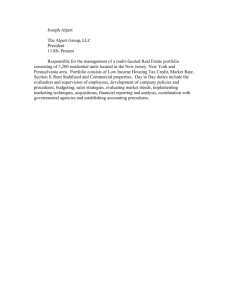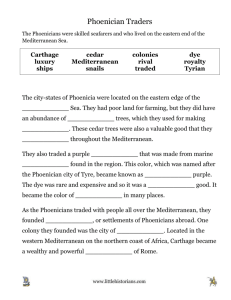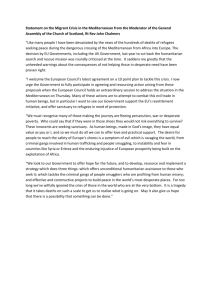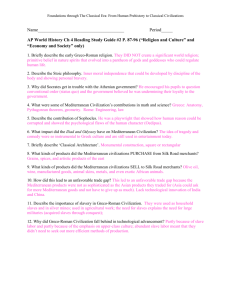פרופ' פנחס אלפרט - שינויי אקלים גלובליים ותחזיות לאזור המזרח התיכון
advertisement
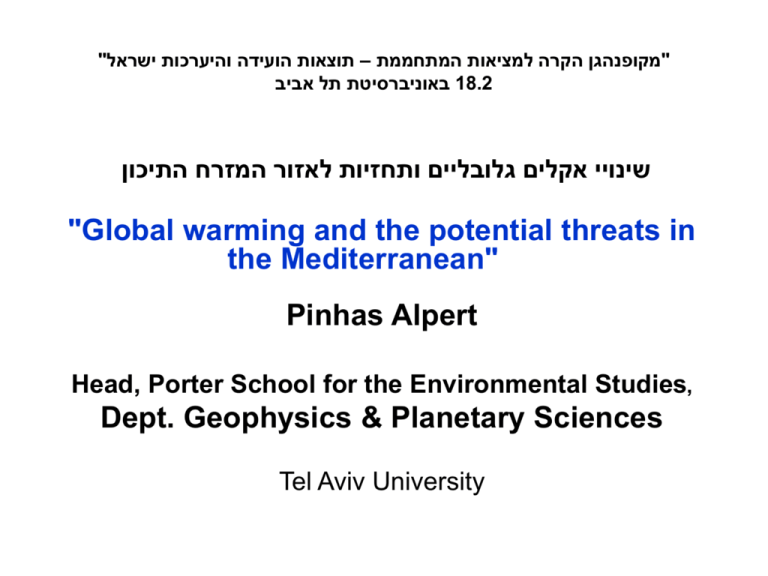
""מקופנהגן הקרה למציאות המתחממת – תוצאות הועידה והיערכות ישראל באוניברסיטת תל אביב18.2 שינויי אקלים גלובליים ותחזיות לאזור המזרח התיכון "Global warming and the potential threats in the Mediterranean" Pinhas Alpert Head, Porter School for the Environmental Studies, Dept. Geophysics & Planetary Sciences Tel Aviv University בעיות עיקריות בחיזוי אקלימי בישראל • תוכנית לאומית מקיפה • חוסר ביכולת מיחשוב גבוהה • בסיסי נתונים זמינים (מטאורולוגיה ,הידרולוגיה,תכסית שטח ,ים ,נתוני קרקע) • שיתופי פעולה בינלאומיים כולל שכנינו • שיתופי פעולה עם מעצבי מדיניות Outline • Global Warming- Some facts. • Temparature & Rainfall trends focus on the Mediterranean region • Extreme Events • Regional Scenarios for Water Management- GLOWA Jordan River Project • Summary Solar insolation Thermal –IR radiation CO2 Methane N2O Graph for 10,000 years showing the huge jump in ALL greenhouse gases at the time of the industrial revolution. טמפרטורת פני כדור הארץ 1850-2100 IPCC AR-4 2007 19 IPCC models (100-200km resolution) – Range of results שינויים בריכוז CO2באטמוספרה Source: CEOS handbook Models with only natural forcings cannot reproduce the observed temperature trend after 1950 Percent Precipitation Change for 2090-2099 relative to 1980-1999 Multi-model Average IPCC AR-4 2007 Trend summer (JJA) 850 mb temperature (°C/100y)NNRP reanalysis Warming trend of 1.5 – 4°C/100y, mostly over W - Med & Egypt, ~3-4 times that of the global trend H. Saaroni, B. Ziv, J. Edelson, and P. Alpert, 2003, Long-term variations in summer temperatures over the Eastern Mediterranean, Geophysical Research Letters, 30, 18, 1946, 2003 (DOI:10.1029/2003GLO17742) Precipitation difference 2071-2100 vs 1961-1990 control run vs. scenarios A2 B2 50-100 mm/y ~50 mm/y Climatic Trends Global super high-resolution run Kitoh, Yatagai and Alpert, 2008: First super-high-resolution model projection that the ancient “Fertile Crescent” will disappear in this century. Hydrological Research Letters, 2, 1-4, DOI: 10.3178/HRL.2.1, 2008. Streamflow changes (m**3/sec) זרימת נהר פרת זרימת נהר הירדן 2081-2100 זרימת נהר טורקיה,סייהאן Kitoh, Yatagai and Alpert, 2008: First super-high-resolution model projection that the ancient “Fertile Crescent” will disappear in this century. ", Hydrolo. Res. Lett., 2, 1-4, DOI: 10.3178/HRL.2.1, 2008. Seasonal changes of monthly mean river discharge of six rivers (19792003; bold), compared to (2075-2099; dashed). Bold-current Dashed- future Except to the Jordan River, all rivers flow into the Mediterranean (m3/s). Bold lines are for current climate, while dashed for the future. Heat wave changes in the eastern Mediterranean since 1960 F. G. Kuglitsch,1,2 A. Toreti,1,2,3 E. Xoplaki,1,4 P. M. Della‐Marta,5 C. S. Zerefos,6 M. Türkeş,7 and J. Luterbacher8 Geophysical Research Letters 17th April 2010 Received 25 November 2009; revised 13 January 2010; accepted 19 January 2010; published 17 February 2010. [1] A new data set of high‐quality homogenized daily maximum and minimum summer air temperature series from 246 stations in the eastern Mediterranean region (including Albania, Bosnia‐Herzegovina, Bulgaria, Croatia, Cyprus, Greece, Israel, Romania, Serbia, Slovenia, Turkey) is developed and used to quantify changes in heat wave number, length and intensity between 1960 and 2006. Daily temperature homogeneity analyses suggest that many instrumental measurements in the 1960s are warm‐biased, correcting for these biases regionally averaged heat wave trends are up to 8% higher. We find significant changes across the western Balkans, southwestern and western Turkey, and along the southern Black Sea coastline. Since the 1960s, the mean heat wave intensity, heat wave length and heat wave number across the eastern Mediterranean region have increased by a factor of 7.6 ± 1.3, 7.5 ± 1.3 and 6.2 ± 1.1, respectively. These findings suggest that the heat wave increase in this region is higher than previously 35 No. of spells 30 Cold 25 Hot Durations (days) of hot/cool spells 1975-1948 20 15 10 5 0 1 2 3 4 5 6 7 8 9 10 11 12 13 14 15 16 17 18 Length (No. of days) No . of spells Cold Hot Heat waves increase & longer Length (No. of days) 2002-1976 Frequency of hot & cold spells in July-Aug in both halfs of 1948-2002 B. Ziv , H. Saaroni, A. Baharad, D. Yekutieli and P. Alpert, "Indications for aggravation in Summer heat conditions over the Mediterranean basin", Geoph. Res. Lett., 32, L12706, doi:10.1029/2005GL022796, 2005. Changes in T-850 mb distributions over the E. Mediterranean • Most frequent value increases •Distribution widens •Increase in heat waves & their intensity B. Ziv , H. Saaroni, A. Baharad, D. Yekutieli and P. Alpert, "Indications for aggravation in Summer heat conditions over the Mediterranean basin", Geoph. Res. Lett., 32, L12706, doi:10.1029/2005GL022796, 2005. ANNUAL AVERAGES 800 annual average precipitation (mm) 700 600 500 400 300 200 100 0 Beer Sheva Dorot Jerusalem Qiryat Anavim Tel Aviv Qiryat Shaul Eilon Yiron Kbutzat Kineret Har Knaan STATION NAME OBSERVATION CONTROL B2 A2 Kfar Blum Kfar Giladi STANDARD DEVIATION 300 standard deviation (mm) 250 200 150 100 50 0 Beer Sheva Dorot Jerusalem Qiryat Anavim Tel Aviv Qiryat Shaul Eilon Yiron Kbutzat Kineret Har Knaan STATION NAME OBSERVATION CONTROL B2 A2 Kfar Blum Kfar Giladi Number of Days for the Extreme Rainfall at Har-Knaan 1961-1990 observed control B2 A2 Over 50 mm/d 24 26 35 26 Over 70 mm/d 6 7 15 10 Over 100 mm/d 1 5 5 5 Over 120 mm/d 1 1 0 3 Conclusion: A factor of 2 (A2) or 3 (B2) of increase in heavy rain days (above 70 mm/d) 0 2059 2056 2053 2050 2047 2044 2041 2038 2035 2032 2029 2026 2023 2020 2017 2014 2011 2008 2005 2002 1999 1996 18 1993 1990 1987 1984 1981 1978 1975 times 20 7-day dry spells RCM Ein Ziw an Maayan Baruch 16 14 12 10 8 6 4 2 0 2059 2056 2053 2050 2047 2044 2041 2038 2035 2032 2029 2026 2023 2020 2017 2014 2011 2008 2005 2002 1999 1996 18 1993 1990 1987 1984 1981 1978 1975 times 3-day wet spells 20 RCM Ein Ziw an Maayan Baruch 16 14 12 10 8 6 4 2 בעיות עיקריות בחיזוי אקלימי בישראל • תוכנית לאומית מקיפה • חוסר ביכולת מיחשוב גבוהה • בסיסי נתונים זמינים (מטאורולוגיה ,הידרולוגיה,תכסית שטח ,ים ,נתוני קרקע) • שיתופי פעולה בינלאומיים כולל שכנינו • שיתופי פעולה עם מעצבי מדיניות Results of First Scenario Panel Meeting Four regional scenarios for future water situation in Israel Results of First Scenario Panel Meeting Identified scenario driving factors influencing future water situation 1. Global climate change 8. Access to and allocation of water 2. Trade 9. Nature conservation 3. Water pollution and treatment 10. Finance & Pricing 4. Energy 11. Demographics 5. Competing water needs between sectors 12. Water supply 6. Values and attitudes 13. Peace / war regional strategies 7. Education 14. Agriculture Results of First Scenario Panel Meeting First draft scenario storylines Results of Second Scenario Panel Meeting Elaborated Storylines “Willingness & ability” - Economic growth / multi-lateral water sharing in which the region flourishes due to lasting peace and world-wide economic growth. “Modest hopes” - Economic growth / unilateral dividing of water - in which outside donors invest heavily in the region to prevent deterioration of the political situation. “Suffering of the weak & environment” - Recession / unilateral dividing of water - in which the economic and political situation in the region stagnates or worsens. “Poverty & peace” - Recession / multi-lateral water sharing – in which the political situation improves but economic growth does not. Scenario driving factors and their respective model driving forces. Scenario Driving Factor Model Driving Force Trade Change in area for water intensive exports Energy X Finance & pricing GDP per capita Water pollution & treatment Change in treated waste water production capacity Competing water needs between sectors X Access to & allocation of water X Water supply (i) Change in desalination capacity; (ii) Change in water use efficiency in the agricultural, domestic and industrial water use sector Values & attitudes X Education X Nature conservation X Demography Population growth rate Peace, war & regional stability X Global warming & cooling Temperature & precipitation for the period 1961 – 2050 X Not quantified Results of Second Scenario Panel Meeting Storylines to Models For example Assumptions about • Human population growth rate • Number of livestock • Grazing rate … LandSHIFT model changes in land cover TRAIN / ZIN Model changes in livestock water consumption changes in water evaporation, transpiration, surface runoff Results phase II: Changes in water availability Simulated, mean changes in water availability (runoff and groundwater recharge) for the two land-use/land-cover change scenarios “Modest Hopes” (left) and “Poverty & Peace” (right). Note that changes from small absolute numbers might result in high percentages. Expected increase (degrees) in Average, Maximum and Minimum daily temperature 40 year change Japanese 20 km change 1990-2030 North Jerusalem Tel Aviv South Tmin 0.8 0.9 0.8 1.0 winter Tave 1.0 0.9 0.8 0.8 Tmax 1.3 1.0 1.0 0.6 Tmin 2.1 1.5 1.2 1.5 summer Tave 1.7 1.6 1.1 1.5 Tmax 1.6 1.6 0.9 1.5 summer Tave 1.6 1.4 1.1 1.2 Tmax 1.9 1.7 1.6 1.3 RegCM 50 km change 2000-2040 North Jerusalem Tel Aviv South Tmin 1.7 2.0 1.9 1.3 winter Tave 2.0 2.0 1.4 2,0 Tmax 1.9 2.6 2.5 1.5 Tmin 1.5 1.3 1.2 1.1 Summary • Global and regional multi-model evaluation indicate strong warming and drying of the Mediterranean region. • Best models currently for Israel at the 20/50 km scale. Good for temperature. For precipitation, sometimes still need bias correction due to orographic effect • Temperature: 1-2 degree increase shown in both global and local models. Japanese model shows higher increase in summer, RegCM shows higher increase in winter. • Precipitation: Japanese and RegCM both show increased interannual variability and probability of multi-year droughts. Different timescale of when precipitation decreases. • Additional information from other climate models (eg. RegCM 25 km) will improve our ability to answer questions such as “what is the probability that there will be a multi-year drought or severe heat wave in the coming decade?” and help inform our planning, policy and adaptive response.
